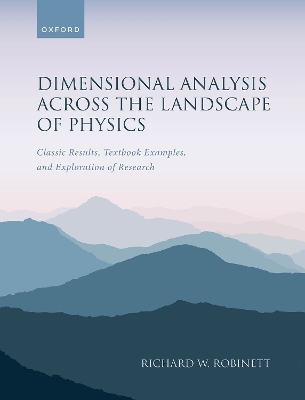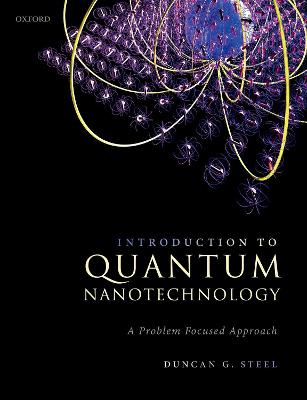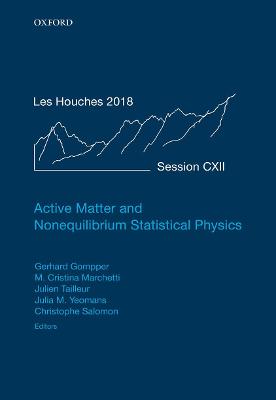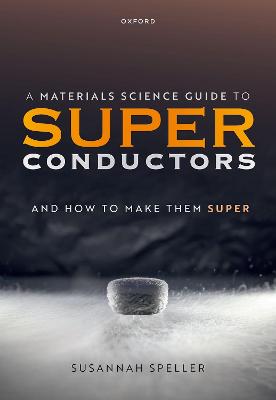Introduction to Quantum Nanotechnology
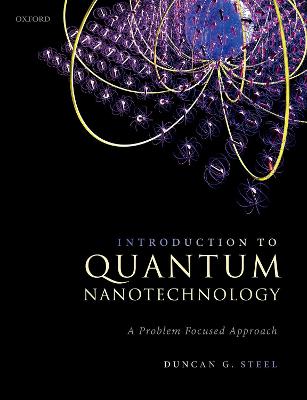 -10%
portes grátis
-10%
portes grátis
Introduction to Quantum Nanotechnology
A Problem Focused Approach
Steel, Duncan G.
Oxford University Press
04/2021
400
Dura
Inglês
9780192895073
15 a 20 dias
1002
Descrição não disponível.
Chapter 1. Introduction to Applied Quantum Mechanics - Why quantum behavior is impacting technology.
Chapter 2. Nano Mechanical Oscillator and Basic Dynamics: Part I
2.1: Introduction
2.2: The Classical Approach: Finding
2.3: The Quantum Approach: Finding
2.4: Is it Classical or Quantum?
2.5: What is Knowable in a Quantum System?
2.6: Coherent Superposition States and Coherent Dynamics
2.7: The Particle and the Wave
2.8: Summary
Chapter 3. Free Particle, Wave Packet and Dynamics, Quantum Dots and Defects/Traps Scattering and Transport.
3.1: Introduction
3.2: The Free Particle
3.3: Localized State in Free Space: The Wave Packet
3.4: Nano-Heterostructures: Quantum Dots and Deep Traps
3.5: A Particle Trapped in a Shallow Defect
3.6: A Particle Trapped in a Point Defect Represented by a Dirac Delta-Function Potential
3.7: Physical Interpretation of the Dirac -function potential
3.8: Summary
Chapter 4. Periodic Hamiltonians and the Emergence of Band Structure: The Bloch Theorem and the Dirac Kronig-Penney model.
4.1: Introduction
4.2: The Translation Operator
4.3: Crystals and Periodic Potentials: The Bloch Theorem and the Dirac Kronig-Penney Model
4.4: Summary
Chapter 5. Scattering, Quantum Current, and Resonant Tunneling
5.1: Introduction
5.2: Scattering
5.3: Tunneling Through a Repulsive Point Defect Represented by a Dirac -Function Potential
5.4: Resonant Tunneling
5.5: Summary
Chapter 6. Bound States in 3-dimensions: The Atom.
6.1: Introduction
6.2: The Hydrogenic Atom
6.3: Summary
Chapter 7. The New Design Rules for Quantum: The Postulates.
7.1: Introduction
7.2: The Postulates of Quantum Mechanics
7.3: The Heisenberg Uncertainty Principle: The Minimum Uncertainty State
7.4: Interpreting the Expansion Coefficients: Relating Functional Form to Dirac Form
7.5: Summary
Chapter 8. Heisenberg Matrix Approach: Nano-Mechanical Oscillator and the Quantum LC Circuit.
8.1: Introduction
8.2: Heisenberg or Matrix Approach to Solving the Time Independent Schroedinger Equation
8.3: Matrix Representation of Operators and Eigenvectors in Quantum Mechanics
8.4: The Quantum LC Circuit
8.5: Summary
Chapter 9. Quantum Dynamics: Rabi Oscillations and Quantum Flip-Flops.
9.1: Introduction
9.2: Time Evolution Operator
9.3: The Heisenberg Picture of Dynamics
9.4: The Interaction Picture
9.5: A Quantum Flip-Flop: Coherent Control of a Two-Level System and Rabi Oscillations
9.6: Summary
Chapter 10. The Quantum Gyroscope: The Emergence of Spin.
10.1: Introduction
10.2: Angular Momentum with the Heisenberg Approach
10.3: Intrinsic Angular Momentum: Spin
10.4: The Bloch Sphere and Spin
10.5: Addition of Angular Momentum
10.6: Angular Momentum and the Rotation Operator
10.7: Summary
Chapter 11. Time Independent and Time Dependent Perturbation Theory.
11.1: Introduction
11.2: Time Independent Perturbation Theory.
11.3: Time Dependent Perturbation Theory: Fermi's Golden Rule
11.4: Summary
Chapter 12. Bosons and Fermions: Indistinguishable particles with intrinsic spin.
12.1: Introduction
12.2: Eigenfunctions and Eigenvalues of the Exchange Operator
12.3: The Exchange Symmetry Postulate: Bosons and Fermions
12.4: The Heitler-London Model
12.5: Summary
Chapter 13. Quantum Measurement and Entanglement: Wave-Function Collapse
13.1: Introduction
13.2: Quantum Measurement
13.3: Quantum Entanglement and the Impact of Measurement
13.4: Quantum Teleportation
13.5: Summary
Chapter 14. Loss and Decoherence: The RLC Circuit
14.1: Introduction
14.2: Coupling to a Continuum of States: The Weisskopf-Wigner Approximation
14.3: Decay in the Nano-Vibrator Problem
14.4: The RLC Circuit
14.5: Summary
Chapter 15. The Quantum Radiation Field: Spontaneous Emission and Entangled Photons
15.1: Introduction
15.2: Finding the Hamiltonian for the Transverse Electromagnetic Field
15.3: Quantizing the Field
15.4: Spontaneous Emission
15.5: The Effects of the Quantum Vacuum on Linear Absorption and Dispersion
15.6: Rabi Oscillations in the Vacuum: The Jaynes Cummings Hamiltonian
15.7: Summary
Chapter 16. Atomic Operators
16.1: Introduction
16.2: Defining the Atomic Operators
16.3: The Physical Meaning of the Atomic Operators
16.4: The Atomic Operators in the Heisenberg Picture
16.5: The Exact Solution for the Atomic Operators for a Monochromatic Field
16.6: The Operator Equations of Motion Including Spontaneous Emission
Chapter 17. Quantum Electromagneticst
17.1: Introduction
17.2: The Number State Representation
17.3: The Coherent State
17.4: Quantum Beam Splitter: Quantum Interference
17.5: Resonant Rayleigh Scattering: A Single Quantum Emitter
17.6: Creating a Quantum Entangled State Between a Photon and an Electron
17.7: Engineering the Quantum Vacuum
17.8: Summary
Chapter 18. The Density Matrix: Bloch Equations
18.1: Introduction
18.2: The Density Matrix Operator
18.3: The Density Matrix Equations Including Relaxation
18.4: Solving the Reduced Density Matrix for a Two-Level System in the Presence of Resonant Classical Electromagnetic Field
18.5: Rate Equation Approximation
18.6: The Three-Level System: Emerging Importance in Quantum Technology
18.7: Summary
Appendices
A: Essential Mathematics Review
B: Power Series for important Functions
C: Properties and Representations for the Dirac Delta Function
D: Vector Calculus and Vector IdentifiesThe Electromagnetic Hamiltonian and the Goepert-Mayer Transformation
E: The Electromagnetic Hamiltonian and the Goepert-Mayer Transformation
F: Maxwell's Equations in Media, the Wave Equation and Coupling to a two-level system
G: Wigner-Eckart Theorem for evaluating matrix elements.
Chapter 2. Nano Mechanical Oscillator and Basic Dynamics: Part I
2.1: Introduction
2.2: The Classical Approach: Finding
2.3: The Quantum Approach: Finding
2.4: Is it Classical or Quantum?
2.5: What is Knowable in a Quantum System?
2.6: Coherent Superposition States and Coherent Dynamics
2.7: The Particle and the Wave
2.8: Summary
Chapter 3. Free Particle, Wave Packet and Dynamics, Quantum Dots and Defects/Traps Scattering and Transport.
3.1: Introduction
3.2: The Free Particle
3.3: Localized State in Free Space: The Wave Packet
3.4: Nano-Heterostructures: Quantum Dots and Deep Traps
3.5: A Particle Trapped in a Shallow Defect
3.6: A Particle Trapped in a Point Defect Represented by a Dirac Delta-Function Potential
3.7: Physical Interpretation of the Dirac -function potential
3.8: Summary
Chapter 4. Periodic Hamiltonians and the Emergence of Band Structure: The Bloch Theorem and the Dirac Kronig-Penney model.
4.1: Introduction
4.2: The Translation Operator
4.3: Crystals and Periodic Potentials: The Bloch Theorem and the Dirac Kronig-Penney Model
4.4: Summary
Chapter 5. Scattering, Quantum Current, and Resonant Tunneling
5.1: Introduction
5.2: Scattering
5.3: Tunneling Through a Repulsive Point Defect Represented by a Dirac -Function Potential
5.4: Resonant Tunneling
5.5: Summary
Chapter 6. Bound States in 3-dimensions: The Atom.
6.1: Introduction
6.2: The Hydrogenic Atom
6.3: Summary
Chapter 7. The New Design Rules for Quantum: The Postulates.
7.1: Introduction
7.2: The Postulates of Quantum Mechanics
7.3: The Heisenberg Uncertainty Principle: The Minimum Uncertainty State
7.4: Interpreting the Expansion Coefficients: Relating Functional Form to Dirac Form
7.5: Summary
Chapter 8. Heisenberg Matrix Approach: Nano-Mechanical Oscillator and the Quantum LC Circuit.
8.1: Introduction
8.2: Heisenberg or Matrix Approach to Solving the Time Independent Schroedinger Equation
8.3: Matrix Representation of Operators and Eigenvectors in Quantum Mechanics
8.4: The Quantum LC Circuit
8.5: Summary
Chapter 9. Quantum Dynamics: Rabi Oscillations and Quantum Flip-Flops.
9.1: Introduction
9.2: Time Evolution Operator
9.3: The Heisenberg Picture of Dynamics
9.4: The Interaction Picture
9.5: A Quantum Flip-Flop: Coherent Control of a Two-Level System and Rabi Oscillations
9.6: Summary
Chapter 10. The Quantum Gyroscope: The Emergence of Spin.
10.1: Introduction
10.2: Angular Momentum with the Heisenberg Approach
10.3: Intrinsic Angular Momentum: Spin
10.4: The Bloch Sphere and Spin
10.5: Addition of Angular Momentum
10.6: Angular Momentum and the Rotation Operator
10.7: Summary
Chapter 11. Time Independent and Time Dependent Perturbation Theory.
11.1: Introduction
11.2: Time Independent Perturbation Theory.
11.3: Time Dependent Perturbation Theory: Fermi's Golden Rule
11.4: Summary
Chapter 12. Bosons and Fermions: Indistinguishable particles with intrinsic spin.
12.1: Introduction
12.2: Eigenfunctions and Eigenvalues of the Exchange Operator
12.3: The Exchange Symmetry Postulate: Bosons and Fermions
12.4: The Heitler-London Model
12.5: Summary
Chapter 13. Quantum Measurement and Entanglement: Wave-Function Collapse
13.1: Introduction
13.2: Quantum Measurement
13.3: Quantum Entanglement and the Impact of Measurement
13.4: Quantum Teleportation
13.5: Summary
Chapter 14. Loss and Decoherence: The RLC Circuit
14.1: Introduction
14.2: Coupling to a Continuum of States: The Weisskopf-Wigner Approximation
14.3: Decay in the Nano-Vibrator Problem
14.4: The RLC Circuit
14.5: Summary
Chapter 15. The Quantum Radiation Field: Spontaneous Emission and Entangled Photons
15.1: Introduction
15.2: Finding the Hamiltonian for the Transverse Electromagnetic Field
15.3: Quantizing the Field
15.4: Spontaneous Emission
15.5: The Effects of the Quantum Vacuum on Linear Absorption and Dispersion
15.6: Rabi Oscillations in the Vacuum: The Jaynes Cummings Hamiltonian
15.7: Summary
Chapter 16. Atomic Operators
16.1: Introduction
16.2: Defining the Atomic Operators
16.3: The Physical Meaning of the Atomic Operators
16.4: The Atomic Operators in the Heisenberg Picture
16.5: The Exact Solution for the Atomic Operators for a Monochromatic Field
16.6: The Operator Equations of Motion Including Spontaneous Emission
Chapter 17. Quantum Electromagneticst
17.1: Introduction
17.2: The Number State Representation
17.3: The Coherent State
17.4: Quantum Beam Splitter: Quantum Interference
17.5: Resonant Rayleigh Scattering: A Single Quantum Emitter
17.6: Creating a Quantum Entangled State Between a Photon and an Electron
17.7: Engineering the Quantum Vacuum
17.8: Summary
Chapter 18. The Density Matrix: Bloch Equations
18.1: Introduction
18.2: The Density Matrix Operator
18.3: The Density Matrix Equations Including Relaxation
18.4: Solving the Reduced Density Matrix for a Two-Level System in the Presence of Resonant Classical Electromagnetic Field
18.5: Rate Equation Approximation
18.6: The Three-Level System: Emerging Importance in Quantum Technology
18.7: Summary
Appendices
A: Essential Mathematics Review
B: Power Series for important Functions
C: Properties and Representations for the Dirac Delta Function
D: Vector Calculus and Vector IdentifiesThe Electromagnetic Hamiltonian and the Goepert-Mayer Transformation
E: The Electromagnetic Hamiltonian and the Goepert-Mayer Transformation
F: Maxwell's Equations in Media, the Wave Equation and Coupling to a two-level system
G: Wigner-Eckart Theorem for evaluating matrix elements.
Este título pertence ao(s) assunto(s) indicados(s). Para ver outros títulos clique no assunto desejado.
Chapter 1. Introduction to Applied Quantum Mechanics - Why quantum behavior is impacting technology.
Chapter 2. Nano Mechanical Oscillator and Basic Dynamics: Part I
2.1: Introduction
2.2: The Classical Approach: Finding
2.3: The Quantum Approach: Finding
2.4: Is it Classical or Quantum?
2.5: What is Knowable in a Quantum System?
2.6: Coherent Superposition States and Coherent Dynamics
2.7: The Particle and the Wave
2.8: Summary
Chapter 3. Free Particle, Wave Packet and Dynamics, Quantum Dots and Defects/Traps Scattering and Transport.
3.1: Introduction
3.2: The Free Particle
3.3: Localized State in Free Space: The Wave Packet
3.4: Nano-Heterostructures: Quantum Dots and Deep Traps
3.5: A Particle Trapped in a Shallow Defect
3.6: A Particle Trapped in a Point Defect Represented by a Dirac Delta-Function Potential
3.7: Physical Interpretation of the Dirac -function potential
3.8: Summary
Chapter 4. Periodic Hamiltonians and the Emergence of Band Structure: The Bloch Theorem and the Dirac Kronig-Penney model.
4.1: Introduction
4.2: The Translation Operator
4.3: Crystals and Periodic Potentials: The Bloch Theorem and the Dirac Kronig-Penney Model
4.4: Summary
Chapter 5. Scattering, Quantum Current, and Resonant Tunneling
5.1: Introduction
5.2: Scattering
5.3: Tunneling Through a Repulsive Point Defect Represented by a Dirac -Function Potential
5.4: Resonant Tunneling
5.5: Summary
Chapter 6. Bound States in 3-dimensions: The Atom.
6.1: Introduction
6.2: The Hydrogenic Atom
6.3: Summary
Chapter 7. The New Design Rules for Quantum: The Postulates.
7.1: Introduction
7.2: The Postulates of Quantum Mechanics
7.3: The Heisenberg Uncertainty Principle: The Minimum Uncertainty State
7.4: Interpreting the Expansion Coefficients: Relating Functional Form to Dirac Form
7.5: Summary
Chapter 8. Heisenberg Matrix Approach: Nano-Mechanical Oscillator and the Quantum LC Circuit.
8.1: Introduction
8.2: Heisenberg or Matrix Approach to Solving the Time Independent Schroedinger Equation
8.3: Matrix Representation of Operators and Eigenvectors in Quantum Mechanics
8.4: The Quantum LC Circuit
8.5: Summary
Chapter 9. Quantum Dynamics: Rabi Oscillations and Quantum Flip-Flops.
9.1: Introduction
9.2: Time Evolution Operator
9.3: The Heisenberg Picture of Dynamics
9.4: The Interaction Picture
9.5: A Quantum Flip-Flop: Coherent Control of a Two-Level System and Rabi Oscillations
9.6: Summary
Chapter 10. The Quantum Gyroscope: The Emergence of Spin.
10.1: Introduction
10.2: Angular Momentum with the Heisenberg Approach
10.3: Intrinsic Angular Momentum: Spin
10.4: The Bloch Sphere and Spin
10.5: Addition of Angular Momentum
10.6: Angular Momentum and the Rotation Operator
10.7: Summary
Chapter 11. Time Independent and Time Dependent Perturbation Theory.
11.1: Introduction
11.2: Time Independent Perturbation Theory.
11.3: Time Dependent Perturbation Theory: Fermi's Golden Rule
11.4: Summary
Chapter 12. Bosons and Fermions: Indistinguishable particles with intrinsic spin.
12.1: Introduction
12.2: Eigenfunctions and Eigenvalues of the Exchange Operator
12.3: The Exchange Symmetry Postulate: Bosons and Fermions
12.4: The Heitler-London Model
12.5: Summary
Chapter 13. Quantum Measurement and Entanglement: Wave-Function Collapse
13.1: Introduction
13.2: Quantum Measurement
13.3: Quantum Entanglement and the Impact of Measurement
13.4: Quantum Teleportation
13.5: Summary
Chapter 14. Loss and Decoherence: The RLC Circuit
14.1: Introduction
14.2: Coupling to a Continuum of States: The Weisskopf-Wigner Approximation
14.3: Decay in the Nano-Vibrator Problem
14.4: The RLC Circuit
14.5: Summary
Chapter 15. The Quantum Radiation Field: Spontaneous Emission and Entangled Photons
15.1: Introduction
15.2: Finding the Hamiltonian for the Transverse Electromagnetic Field
15.3: Quantizing the Field
15.4: Spontaneous Emission
15.5: The Effects of the Quantum Vacuum on Linear Absorption and Dispersion
15.6: Rabi Oscillations in the Vacuum: The Jaynes Cummings Hamiltonian
15.7: Summary
Chapter 16. Atomic Operators
16.1: Introduction
16.2: Defining the Atomic Operators
16.3: The Physical Meaning of the Atomic Operators
16.4: The Atomic Operators in the Heisenberg Picture
16.5: The Exact Solution for the Atomic Operators for a Monochromatic Field
16.6: The Operator Equations of Motion Including Spontaneous Emission
Chapter 17. Quantum Electromagneticst
17.1: Introduction
17.2: The Number State Representation
17.3: The Coherent State
17.4: Quantum Beam Splitter: Quantum Interference
17.5: Resonant Rayleigh Scattering: A Single Quantum Emitter
17.6: Creating a Quantum Entangled State Between a Photon and an Electron
17.7: Engineering the Quantum Vacuum
17.8: Summary
Chapter 18. The Density Matrix: Bloch Equations
18.1: Introduction
18.2: The Density Matrix Operator
18.3: The Density Matrix Equations Including Relaxation
18.4: Solving the Reduced Density Matrix for a Two-Level System in the Presence of Resonant Classical Electromagnetic Field
18.5: Rate Equation Approximation
18.6: The Three-Level System: Emerging Importance in Quantum Technology
18.7: Summary
Appendices
A: Essential Mathematics Review
B: Power Series for important Functions
C: Properties and Representations for the Dirac Delta Function
D: Vector Calculus and Vector IdentifiesThe Electromagnetic Hamiltonian and the Goepert-Mayer Transformation
E: The Electromagnetic Hamiltonian and the Goepert-Mayer Transformation
F: Maxwell's Equations in Media, the Wave Equation and Coupling to a two-level system
G: Wigner-Eckart Theorem for evaluating matrix elements.
Chapter 2. Nano Mechanical Oscillator and Basic Dynamics: Part I
2.1: Introduction
2.2: The Classical Approach: Finding
2.3: The Quantum Approach: Finding
2.4: Is it Classical or Quantum?
2.5: What is Knowable in a Quantum System?
2.6: Coherent Superposition States and Coherent Dynamics
2.7: The Particle and the Wave
2.8: Summary
Chapter 3. Free Particle, Wave Packet and Dynamics, Quantum Dots and Defects/Traps Scattering and Transport.
3.1: Introduction
3.2: The Free Particle
3.3: Localized State in Free Space: The Wave Packet
3.4: Nano-Heterostructures: Quantum Dots and Deep Traps
3.5: A Particle Trapped in a Shallow Defect
3.6: A Particle Trapped in a Point Defect Represented by a Dirac Delta-Function Potential
3.7: Physical Interpretation of the Dirac -function potential
3.8: Summary
Chapter 4. Periodic Hamiltonians and the Emergence of Band Structure: The Bloch Theorem and the Dirac Kronig-Penney model.
4.1: Introduction
4.2: The Translation Operator
4.3: Crystals and Periodic Potentials: The Bloch Theorem and the Dirac Kronig-Penney Model
4.4: Summary
Chapter 5. Scattering, Quantum Current, and Resonant Tunneling
5.1: Introduction
5.2: Scattering
5.3: Tunneling Through a Repulsive Point Defect Represented by a Dirac -Function Potential
5.4: Resonant Tunneling
5.5: Summary
Chapter 6. Bound States in 3-dimensions: The Atom.
6.1: Introduction
6.2: The Hydrogenic Atom
6.3: Summary
Chapter 7. The New Design Rules for Quantum: The Postulates.
7.1: Introduction
7.2: The Postulates of Quantum Mechanics
7.3: The Heisenberg Uncertainty Principle: The Minimum Uncertainty State
7.4: Interpreting the Expansion Coefficients: Relating Functional Form to Dirac Form
7.5: Summary
Chapter 8. Heisenberg Matrix Approach: Nano-Mechanical Oscillator and the Quantum LC Circuit.
8.1: Introduction
8.2: Heisenberg or Matrix Approach to Solving the Time Independent Schroedinger Equation
8.3: Matrix Representation of Operators and Eigenvectors in Quantum Mechanics
8.4: The Quantum LC Circuit
8.5: Summary
Chapter 9. Quantum Dynamics: Rabi Oscillations and Quantum Flip-Flops.
9.1: Introduction
9.2: Time Evolution Operator
9.3: The Heisenberg Picture of Dynamics
9.4: The Interaction Picture
9.5: A Quantum Flip-Flop: Coherent Control of a Two-Level System and Rabi Oscillations
9.6: Summary
Chapter 10. The Quantum Gyroscope: The Emergence of Spin.
10.1: Introduction
10.2: Angular Momentum with the Heisenberg Approach
10.3: Intrinsic Angular Momentum: Spin
10.4: The Bloch Sphere and Spin
10.5: Addition of Angular Momentum
10.6: Angular Momentum and the Rotation Operator
10.7: Summary
Chapter 11. Time Independent and Time Dependent Perturbation Theory.
11.1: Introduction
11.2: Time Independent Perturbation Theory.
11.3: Time Dependent Perturbation Theory: Fermi's Golden Rule
11.4: Summary
Chapter 12. Bosons and Fermions: Indistinguishable particles with intrinsic spin.
12.1: Introduction
12.2: Eigenfunctions and Eigenvalues of the Exchange Operator
12.3: The Exchange Symmetry Postulate: Bosons and Fermions
12.4: The Heitler-London Model
12.5: Summary
Chapter 13. Quantum Measurement and Entanglement: Wave-Function Collapse
13.1: Introduction
13.2: Quantum Measurement
13.3: Quantum Entanglement and the Impact of Measurement
13.4: Quantum Teleportation
13.5: Summary
Chapter 14. Loss and Decoherence: The RLC Circuit
14.1: Introduction
14.2: Coupling to a Continuum of States: The Weisskopf-Wigner Approximation
14.3: Decay in the Nano-Vibrator Problem
14.4: The RLC Circuit
14.5: Summary
Chapter 15. The Quantum Radiation Field: Spontaneous Emission and Entangled Photons
15.1: Introduction
15.2: Finding the Hamiltonian for the Transverse Electromagnetic Field
15.3: Quantizing the Field
15.4: Spontaneous Emission
15.5: The Effects of the Quantum Vacuum on Linear Absorption and Dispersion
15.6: Rabi Oscillations in the Vacuum: The Jaynes Cummings Hamiltonian
15.7: Summary
Chapter 16. Atomic Operators
16.1: Introduction
16.2: Defining the Atomic Operators
16.3: The Physical Meaning of the Atomic Operators
16.4: The Atomic Operators in the Heisenberg Picture
16.5: The Exact Solution for the Atomic Operators for a Monochromatic Field
16.6: The Operator Equations of Motion Including Spontaneous Emission
Chapter 17. Quantum Electromagneticst
17.1: Introduction
17.2: The Number State Representation
17.3: The Coherent State
17.4: Quantum Beam Splitter: Quantum Interference
17.5: Resonant Rayleigh Scattering: A Single Quantum Emitter
17.6: Creating a Quantum Entangled State Between a Photon and an Electron
17.7: Engineering the Quantum Vacuum
17.8: Summary
Chapter 18. The Density Matrix: Bloch Equations
18.1: Introduction
18.2: The Density Matrix Operator
18.3: The Density Matrix Equations Including Relaxation
18.4: Solving the Reduced Density Matrix for a Two-Level System in the Presence of Resonant Classical Electromagnetic Field
18.5: Rate Equation Approximation
18.6: The Three-Level System: Emerging Importance in Quantum Technology
18.7: Summary
Appendices
A: Essential Mathematics Review
B: Power Series for important Functions
C: Properties and Representations for the Dirac Delta Function
D: Vector Calculus and Vector IdentifiesThe Electromagnetic Hamiltonian and the Goepert-Mayer Transformation
E: The Electromagnetic Hamiltonian and the Goepert-Mayer Transformation
F: Maxwell's Equations in Media, the Wave Equation and Coupling to a two-level system
G: Wigner-Eckart Theorem for evaluating matrix elements.
Este título pertence ao(s) assunto(s) indicados(s). Para ver outros títulos clique no assunto desejado.


